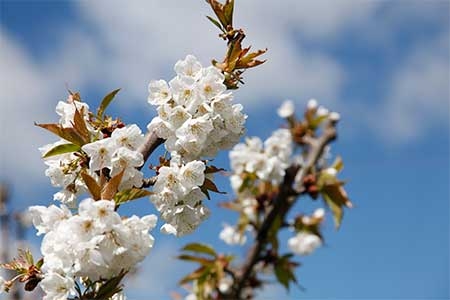Benefits of chemical thinning: To achieve good thinning and fruit quality, all chemical thinners need to be applied at the appropriate physiological stage and under the climatic conditions best suited to each chemical.
Choice of thinning chemical is important, as some cultivars do not respond well to some chemicals.
Netted orchards (cont from last issue)
Fruit set in trees under hail netting tends to be lower than uncovered trees.
Due to the lower light levels, chemically thinning netted trees often induces greater fruitlet drop, hence care should be taken to avoid over thinning.
While low blossom trees under nets might not require chemical thinning, trees with medium to heavy blossoms will still benefit from chemical thinning to minimise or eliminate the need for follow-up hand thinning.
Artificial spur extinction
Also referred to as bud extinction, artificial spur extinction (ASE) is a crop load management method using bud selection and thinning techniques to precisely define where and how much fruit is set on the tree.
This precision method of crop-load control is done before budbreak, effectively partially thinning the tree before flowering and also markedly reducing the tree total floral bud load (typically by 50% or more) compared with that of unmodified trees.
Because bud numbers are set in late winter before growth starts in early spring, trees begin spring growth in an already significantly ‘crop thinned’ state, so at budburst, ASE trees will be carrying fewer, but stronger flower buds than conventional trees.
Hence trees can direct more resources into these buds, potentially carrying a more optimum crop load of quality fruit for the tree size and structure.
ASE eliminates the need for chemical thinning. Note that ASE studies have only been undertaken on apples in Australia.
General guidelines
• Get the tree structure right—six branches per metre of tree height; dominant branches removed; upright branches tied down
• Determine the target crop load.
• Thin spur and terminal buds by hand to the predetermined density, systematically selecting and spacing out only the largest and strongest buds
• Remove axillary floral buds.
Setting bud numbers
Impose ASE at branch unit level:
• work one branch at a time, starting at the lowest branch; treat the top of the tree as a branch.
• determine the number of buds required—the standard bud density is six buds per cm2 limb cross-sectional area (LCSA), but this can be adjusted up or down depending on the desired crop load and fruit size.
• until familiar with this technique, use an equilifruit disc to measure branch diameter and check the disc for bud numbers required.
Systematically and selectively remove floral buds from the branch to required type, position and number:
• space buds along the branch, selectively retaining strong, large spurs and short to medium course shoots.
• remove weak, crowded and poorly positioned buds; run secateurs along the branch underside to rapidly remove shaded buds/ spurs.
• simplify complex shoots and spurs.
• remove the majority of axillary buds at the tight cluster stage by running your thumb and forefinger down first year wood to strip, this will leave one bud every 10–15 cm.
Because artificial spur extinction reduces floral bud numbers, it is vital that a high success rate of fruit set is achieved on the retained buds.
Reducing floral bud numbers enhances fruit set in the retained floral buds as there is less competition, so it is normal for over 90% of buds on ASE-managed trees to set fruit, unlike conventionally managed trees in which 50% or more of buds can fail to set.
Once spur extinction is completed, the major annual thinning effort for the crop is already done—before budbreak and the early season demand for carbohydrate reserves!
Hand-thinning
Hand thinning ASE trees is simple because spacing, position and number of clusters are already set—all that is required is to thin the clusters to singles and the occasional double according to the total number of fruit per tree that is required.
Due to the reduced initial fruit load, ASE-managed trees do not express late fruitlet drop as there is no excessive fruit set that invokes fruit-shedding, so hand-thinning to adjust crop load to the final desired numbers can be started within 3–4 weeks of flowering rather than waiting for fruit drop in December.
Summary
The earlier that excess flowers/fruit are removed, regardless of the method, the larger the size and better the quality of fruit at harvest.
If choosing chemical thinners, it is important to implement a structured program using both bloom and post-bloom thinners. However, chemical thinners are not capable of spacing fruit evenly and it can be difficult to apply chemicals at the correct times and under optimal conditions due to the unpredictable spring weather conditions.
Artificial spur extinction offers a new technology to precisely manage the crop load, maximising cropping on the strongest buds in the tree and spatially distributing buds so that fruit develops optimally.
There is also the advantage that it is not weather dependent.
To maximise the benefits of any crop load management technique or program, good overall tree management is important. The greatest benefits are achieved where all aspects of fruit production are well managed, for example where an orchard is subjected to water stress or nutrition is lacking, regulating crop load is unlikely to substantially increase fruit size or quality.
Download the Orchard plant protection guide
See this article in Tree Fruit Oct 2020






















